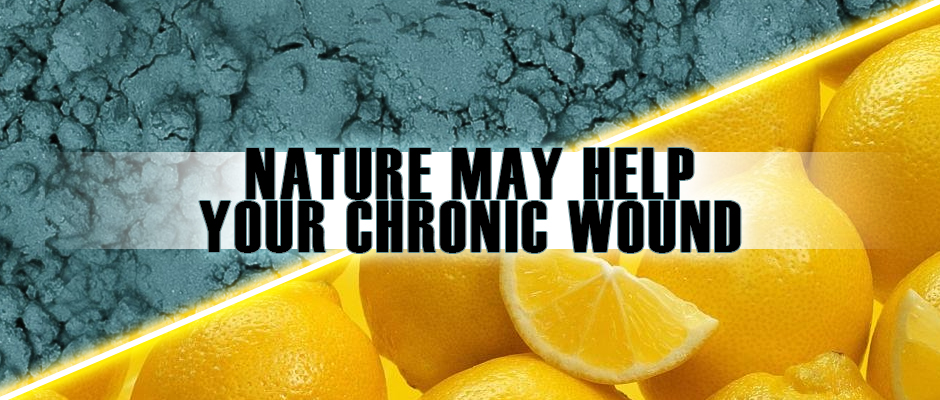Two More Alternative Options for Chronic Wounds
Dealing with a chronic wound or skin infection can be difficult. Our immune system plays a critical role in wound healing. However, facing a chronic infection or wound can create a higher level of concern or anxiety. Well, such stress alters your immune system’s ability to heal wounds. As you can imagine, the situation can become a vicious circle of circumstances perpetuating the problem. Something needs to be done to break the cycle. So, let’s talk about a couple of alternative options for chronic wounds.
I have written about alternative options for chronic wounds before. Those recommendations are still viable. However, if you are dealing with this condition, I do not have to tell you that there are numerous ways to approach such wounds, and not all of them will work. Moreover, some will simply work better than others.
Some work, and some do not because there are a variety of different factors that impact different people. Some may be dealing with MRSA, some may be dealing with strep, yet others might be dealing with something altogether different. The point is that there is not a silver bullet for every condition. Unfortunately, trial and error is sometimes the way to approach such a disease.
Thankfully, we have a strong understanding of how wounds heal and where things get messed up. Generally speaking, there is a bleeding, an inflammatory, a proliferative, and a remodeling phase. Unfortunately, with chronic wounds and infections, the healing process generally gets stuck in the inflammatory phase.
Before we move on, we need to get a few notes out of the way. Let us understand some things that help create or exacerbate a chronic wound. I have already mentioned stress, but underlying conditions such as diabetes, vascular diseases, limited mobility, repeated trauma to the wound site, infection-causing bacteria, and edema can all play a big part in keeping your wound from healing. Your first step will always be attempting to resolve such issues or, at the very least, trying to keep such conditions under control.
Getting such health conditions under control will likely require some exercise and an adjustment in your diet. Too many live sedentary lifestyles and adhere to the Standard American Diet (SAD). The first recommendation is to get moving. It would help if you were shooting for no less than 150 minutes of moderate physical activity a week. This will get the blood flowing and ensure that your systems are working.
From there, we need to understand that over half of the population is dealing with some chronic ailment (diagnosed or not), and over 92% of the population is dealing with a vitamin or mineral deficiency. If you are dealing with a chronic wound, you already fit into the first category, and the chances are good that you already fall into the second category as well. In fact, this alone might be hindering your progress. Start by eating quality foods. For healing, I often recommend something like the Mediterranean Diet or the “Tribal Diet.” With that, avoid refined sugars and flour where possible, and try to avoid simple starches.
We also need to understand that the best diet in the world is useless if you cannot absorb the nutrients. Therefore, we must work to improve our gut health. I will not delve into that too much here (because I have written about it in other articles), but it is essential to understand the importance of this. Low-inflammatory foods, probiotics, prebiotics, plenty of fruits, and fish are crucial. However, understanding that time is not on our side and that our bodies need the nutrients as soon as possible, you might want to talk to your doctor about IV vitamins and minerals. This could potentially kick-start the healing process. Such a tactic is not unheard of in those with digestion issues.
If we’ve addressed all the preceding and can still not combat the wound or skin infection, we must understand that you might be dealing with a pH issue. Your skin’s pH will vary during the healing process. Instead of having a neutral pH, the skin will usually shift to a more acidic pH during healing. However, with some chronic wounds, something gets messed up, and the pH shifts to alkaline. What can we do since we cannot usually eat our way into a pH shift? Actually, we have a couple of excellent alternative options for chronic wounds.
Oregon Blue Clay
Researchers have discovered that a blue clay found in Oregon has some antibacterial and pH-shifting properties. According to researchers and the National Science Foundation, not only can the blue clay kill pathogenic bacteria such as MRSA, but it can also address other potentially problematic bacteria such as E. coli and S. epidermidis. Furthermore, they theorize that the clay likely shifts the wound environment to a pH range that aids healing. An added benefit is the mineralization of the tissue, which boasts a slew of unrelated benefits. You can find this research in the International Journal of Antimicrobial Agents.
Sources to Consider: 1, 2, 3, 4
The Recommendation
Take the blue clay and make a paste. Place the clay paste over the wound and allow it to dry. Once the paste has dried completely, you can gently rinse it off. Ensure that you do not scrub it out. It may take several days to weeks to see the results.
Product Recommendation
Citric Acid
Almost counter-intuitively, the topical application of diluted citric acid can create the environment necessary to complete the healing process. Several studies have found that manually making the acidic environment not only helps encourage the body to heal the wound but also helps control the infection, increase the antimicrobial activity, release necessary oxygen in the tissue, and reduce the toxic load. The most impressive attribute is that applying citric acid can encourage the epithelial cells to migrate upwards and repair the wounded area (the most important part of wound healing), encouraging new blood vessels to form from the existing vessels.
Sources to Consider: 1, 2, 3, 4
The Recommendation
You will want some distilled water, citric acid powder, a spray mist bottle, some gauze pads or wound dressings, and a container for the leftover fluid.
- NOTE: you are seeking a 3 to 5% solution. It is not wise to go over this percentage. A higher percentage is NOT better.
Step 1 – To make the 5% solution, place two tablespoons of citric acid powder in 1 pint (2 cups) of boiled water. Let cool, and then put the solution into your bottles accordingly.
Step 2 – Once cooled, soak a gauze pad with the solution and dress the wound accordingly. The solution will remain on the skin and eventually dry in about 8 to 12 hours. Apply a single daily application for severe wounds and once every other day for less serious ones.
- NOTE: this method may result in temporary maceration, sometimes called hyperhydration. The skin will temporarily lighten because the skin under the bandage becomes wet. This is normal.
- NOTE: If this solution is too strong, back it down to 2 teaspoons and work your way up.
- WARNING: This might sting a little at first.
Step 3 – Using a mist sprayer, you mist the affected skin throughout the day (roughly 5 to 6 times daily).
- HINT: the citric acid mist might also be good for acne.
- WARNING: Avoid the eyes and other mucus membranes.
Product Recommendation
Conclusion
While such solutions may take a little time, understand there is still hope and more things you can try. That said, just like any other potential solution, know that one size does not fit all. These alternative options for chronic wounds may or may not be the solutions you seek. Nevertheless, there are two more options to consider and try. The best news is that they are both relatively inexpensive, backed by research, and highly effective in certain situations. Along with a solid diet and moderate activity, you might be well on your way to resolving your condition.
NOTE: There is a decent amount of research available regarding both options. The links provided herein are just a small sampling of what is out there. Please do your research and decide what is best for you.
This article was written from a Health Science perspective. Dr. Robertson is a health researcher and educator, not a physician. The information provided here is not medical advice, a professional diagnosis, opinion, treatment, or service to you or any other individual. The information provided is for educational and anecdotal purposes and is not a substitute for medical or professional care. You should not use the information in place of a visit, call consultation, or the advice of your physician or other healthcare providers. Dr. Robertson is not liable or responsible for any advice, course of treatment, diagnosis, or additional information, services, or product you obtain or utilize. IF YOU BELIEVE YOU HAVE A MEDICAL EMERGENCY, YOU SHOULD IMMEDIATELY CALL 911 OR YOUR PHYSICIAN.




